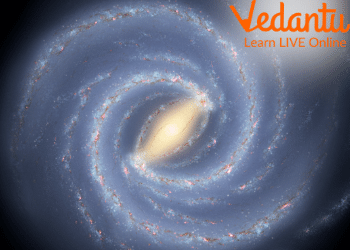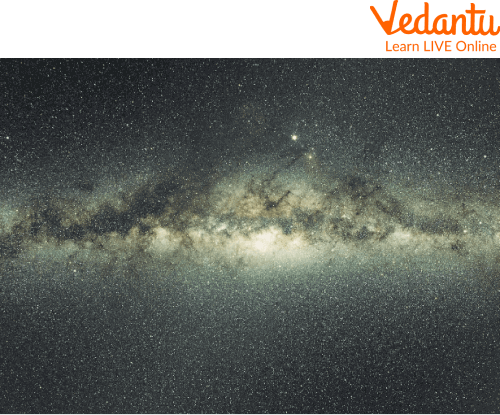




Why Is the Milky Way Important? Key Facts and Scientific Concepts
The Milky Way is our galaxy, where we live, and where our solar system is located. It is named so because of the white patches we see when we look at it from the Earth. Scientists estimate that there are more than 100 billion galaxies in the observable universe, many times more than all the grains of sand on Earth's beaches.
In this article, we are going to discuss some Milky Way facts in detail. So, let's look forward to some more amazing facts about the Milky Way galaxy. We will also discuss what are the things present inside the Milky Way.

The Milky Way a Galaxy Full of Stars, Dust, and Gas
What is the Milky Way?
The Milky Way is a huge collection of stars. Dust and clouds of gases are also present there. The Milky Way has billions of stars. It contains at least 100 billion planets.
Size of the Milky Way Galaxy
American astronomer Harlow Shapley estimated the Milky Way Galaxy's size for the first time with certainty in 1917. He calculated the diameter of the Galaxy, assuming that the globular clusters surrounded it, to be roughly 100,000 light-years.
The Milky Way is 150,000 light years in diameter and 100,000 light years in thickness. The Sun is one of the stars in the Milky Way. Earth and all the other planets also exist in the Milky Way. When seen from above, it looks like a giant pinwheel.
How Old is the Milky Way?
It is believed that the Milky Way galaxy is about 13.6 billion years old. However, thanks to a telescope called Gaia, astronomers now have the most accurate measurement of the Milky Way’s age. As it turns out, it is far older than previously thought. Data now suggests that the Milky Way began to form around 13-billion years ago, or about 800-million years after the Big Bang.

Milky Way Galaxy
Interesting Facts About the Milky Way
Let’s learn some amazing facts about the Milky Way galaxy
It has a halo, but you can't see it straight away - Dark matter, which gives our galaxy its enigmatic halo, is thought to make up 90% of its mass, according to scientists. Thus, less than 10% of the mass of the Milky Way is represented by all of the "luminous matter" - that is, the material that can be seen with the unaided eye or via a telescope. Its halo is not the typical brilliant kind we typically imagine when imagining angels or looking at comets.
Our galaxy Milky Way has over 200 million stars
There is a big hole in the centre of the galaxy that is known as a black hole.
The Milky Way is believed to be as old as the total life of the universe.
It is part of a big cluster by itself that is named as Virgo supercluster.
From these Milky Way Galaxy facts, we now know that the Galaxy has millions of stars, it is very old and there are a lot of clusters in the universe.
Summary
To comprehend the Milky Way facts, we know there are several galaxies present in the universe, the common thing that they all have are stars, dust, planetary objects, and gases, they all have different shapes and sizes. One of them is the spiral form of the galaxy that we have, which is the Milky Way. Our galaxy has stars, dust, gases, and plants. Like other cosmic objects such as asteroids, meteoroids, comets, galaxies, and planets, the Milky Way is one of them.
FAQs on Facts About the Milky Way Every Student Should Know
1. What are Superclusters? What is the nearest Supercluster to the Earth?
Superclusters are groups of galaxies with similar properties, typically made up of tens to thousands of individual galaxy clusters. Virgo is a supercluster that lies in the direction of the Earth's solar system. They overlap with other nearby superclusters and continue much further than our own Milky Way galaxy, so astronomers can't get a complete picture of what such an object looks like from Earth.
2. Write about the three common types of galaxies.
The Three types of galaxies are spiral, irregular, and elliptical galaxies.
In a spiral galaxy, the stars, gas, and dust are in a way that takes the shape of spiral rings which further strengthen and form permanent arms. Our galaxy is also a part of a spiral galaxy, which is a Milky Way galaxy.
Elliptical galaxies are curved as ellipses (stretched circles). These galaxies consist of old stars and are bigger ones. Elliptical galaxies come in various sizes.
Irregular galaxies are of no regular shape. They have ranked the smallest galaxies made up of stars and dust, the presence of a lot of gas and dust ensures the regular formation of stars which makes them bright.
3. What is a black hole and what are its types?
The black hole is an area in space where gravity pulls so strongly that nothing, not even light, can escape. There are two types of black holes: stellar-mass and supermassive. Stellar-mass black holes form when the core of a large star collapses into a tiny point called a singularity. It doesn't end there, however. The other type is a supermassive black hole, which is most often found at the centre of galaxies.









